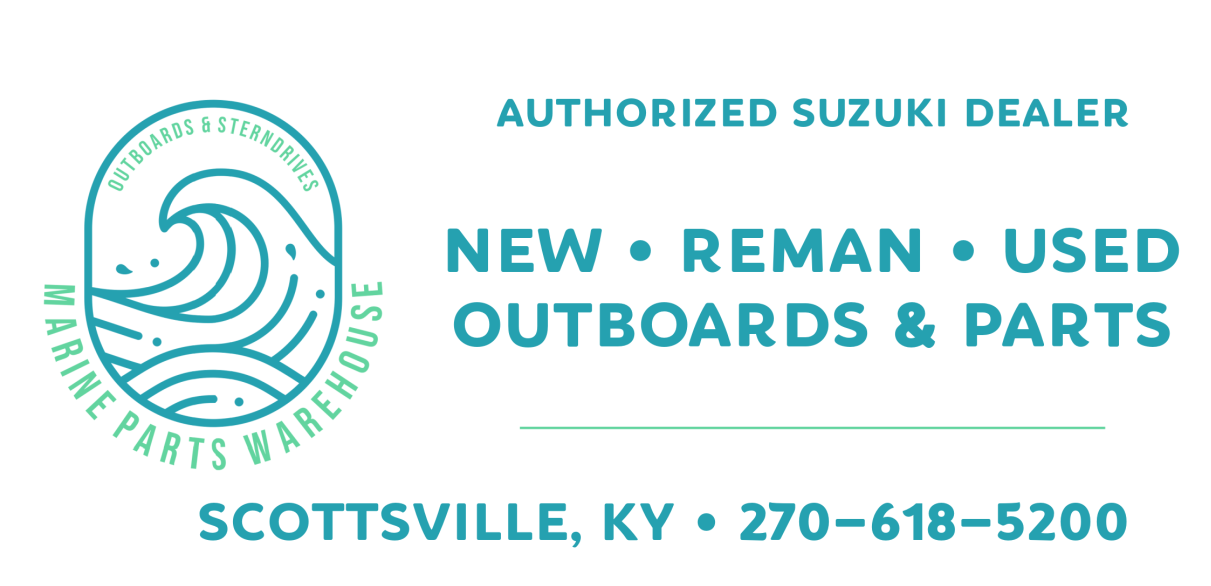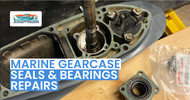Best Marine Seals and Bearings for Gearcase Repair and Their Maintenance
The lower unit, commonly known as the outboard gearcase, is the part that translates the engine power into motion. This part is always operating in a very challenging environment, where it is constantly exposed to water, dust, and high rotational speeds.
At the heart of the gearcase are two critical elements: the bearings and marine seals. Their task is straightforward but essential: bearings facilitate smooth, low-friction movement of moving parts, and seals prevent water from entering, protecting the gear oil.
When a marine gearcase fails, it is usually the fault of these two small parts. Even a minor leak or premature bearing wear can ruin expensive gears or shafts, potentially leading to a catastrophic failure.
This OBParts guide will help you recognize the early signs and empower every boat captain and weekend angler with the knowledge to perform gearcase repairs.
Recognizing the Warning Signs
A failing gearcase rarely breaks down without giving some warning signs. Knowing what to look for can save you thousands of dollars. So, pay close attention to these signs of the outboard gearcase wear.
Symptoms of Seal Failure
Seal failure is almost always indicated by the presence of water inside the gearcase. They are designed to create a perfect barrier, and any breach is a sign of trouble.
- Milky or Foamy Gear Oil: If you remove the cover of the gear case to check it, and see that the oil appears milky or foamy, then water has infiltrated into the lubricant. This dramatically compromises its performance and endangers your gears by overstraining.
- Prop Shaft Oil Leak: If you notice a small oil puddle under the prop shaft after running, that's a leak. This is an issue that needs to be resolved immediately to avoid further destruction and costly repairs.
- Corrosion Around the Seals: If you spot white, crusty build-up and pitting on the area where your gearcase housing is located (specifically around the prop shaft or drive shaft). This is an indicator that saltwater is migrating beyond a deteriorating seal.
- Excessive Play in the Propeller Shaft: This can also be a bearing issue, but a severely worn prop shaft seal allows the shaft to move and wobble, leading to uneven wear and surrounding components.
Symptoms of Bearing Failure
Bearings are designed to be durable, but not impervious. When they do begin to fail, they will typically announce their presence through sensations and sounds.
- Grinding, Whining, or Growling Noises: A good gearcase will operate quietly. A grinding, whining, or growling noise is typically a sign of a failed bearing, especially in neutral or under a low idle speed.
- Metal Shavings in Gear Oil: As you drain gear oil, inspect for metal particles. Tiny silvery flakes are common, but larger pieces indicate a decaying marine bearing.
- Difficulty in Shifting Gears: Although this may be a separate issue, a failing thrust bearing can cause the gear set to misalign, making it difficult to shift into forward or reverse gear.
Type of Gearcase Seals and Bearings Used in Gearcase
Marine gearcases are complex systems with different types of components working in harmony.
Type of Marine Gearcase Seals
Seals are named by their location and the shaft they protect. All the seals and gaskets are vital to maintain the integrity of the lower unit.
- Prop shaft seals: Located at the end of the gearcase, where the prop shaft exits the housing. They typically feature a double-lip design for added protection.
- Drive shaft seals: Found at the top of the gearcase, where the drive shaft enters from the engine’s powerhead.
- Shift shaft seals: Positioned where the shift shaft enters the gearcase. This is a small but equally important seal that prevents both oil leaks and water intrusion.
- O-rings and gaskets: They are not the traditional “seals”; these are essential for sealing static parts of the gearcase.
Types of Bearings
Each bearing in the gearcase serves a specific purpose, supporting different loads and maintenance requirements.
- Tapered roller bearings: These bearings are found on the drive shaft. They handle both radial and thrust loads.
- Needle bearings: These are tiny, thin roller bearings used in tight places, such as inside gears.
- Ball bearings: The simple and versatile ball bearings support shafts that experience lighter radial loads.
- Thrust bearings: These bearings are designed to handle axial or thrust loads. They are critical for absorbing the forward and reverse forces.
Moreover, pick bearings rated for marine use, corrosion resistance, load, and speed of your application.
How to Choose the Best Marine Seals and Bearings for Gearcase Repairs
When it comes to rebuilding your marine gearcase, all seals and bearings are not created equal. Selecting the proper parts can help your engine run effectively and not fall victim to repeated failures. Here is what to consider when buying:
1. OEM vs Aftermarket
OEM (Original Equipment Manufacturer) quality ensures a perfect fit and factory-grade performance.
Aftermarket choices can be less expensive, and as long as they’re coming from a reputable source like OBParts, for the most part, equal or surpass OEM quality.
2. Material Quality
And when it comes to seals, follow your owner's manual and look for ones constructed from tough rubber compounds that withstand exposure to saltwater, UV, and the elements.
The bearings must be machined in very strong stainless steel or special hardened alloys to last.
3. Compatibility
Always cross-reference part numbers with your engine’s make, model, and year. Even slight variations can cause leaks or premature wear.
4. Application-Specific Design
- Prop shaft seals prevent water intrusion around the prop.
- Drive shaft seals protect against leaks near the powerhead.
- Shift shaft seals keep gear changes smooth.
- Matching each seal or bearing to its location is key to reliability.
5. Brand Reputation
Stick with trusted marine brands (Yamaha, Mercury, Johnson/Evinrude, Suzuki, etc.) or proven aftermarket suppliers carried by OBParts.
A Step-by-Step Overview of the Repair Process

Gearcase repair is an essential part of boat maintenance. The repair project is perfect for both DIYers and professional mechanics. I always recommend consulting your specific engine’s service manual for precise instructions and torque specifications. This overview will give a clear understanding of the process.
1. Draining the Gear Oil
- Remove gearcase drain and vent plugs
- Empty the gearcase oil into a clean container
- Inspect oil for water, metal shavings, or debris.
2. Disassembly
- Remove the lower unit (in outboards) or housing covers (in sterndrives).
- Remove propeller, prop shaft nuts or retainers, and coupling assemblies.
- Unbolt housing halves or covers, carefully separating them.
3. Seal and Bearing Removal
- Use seal pullers, screw extraction, or small screwdrivers to catch the lip and pry out seals. (Many DIYers use self-tapping screws in the old seal lip to pull it.)
- For bearings or bearing carriers, a puller or press may be needed.
- In frozen cases, heating the housing can help loosen the bearing carrier. Some mariners use the prop-nut trick (tightening the prop nut with wood blocks) to pull the shaft and bearing carrier.
4. Inspection and Cleaning
- Inspect all surfaces, shafts, and bearing bores for wear, pitting, or corrosion
- Clean all parts thoroughly with solvent and dry
- Check the bore tolerances and acceptability for new seals/bearings.
5. Installation
This is the crucial step, and proper alignment is essential to prevent premature failure.
- Lightly lubricate the new seals with marine grease before installation
- Press bearing evenly using a press or driver
- Install the seals properly by gently pressing them into place. Use a hydraulic press or bearing press tool to install the new bearings.
6. Reassembly and Final Test
- Reassemble housing halves, torque bolts to spec
- Reinstall the propeller, shift rod, and any coupling assemblies
- Fill with fresh, correct gear oil
- Use vacuum or pressure testing to confirm the integrity of seals.
- Slowly test the unit in neutral and forward & reverse gear at low RPM to check for leaks, vibration, or anomalies.
Maintenance Tips to Extend Seal and Bearing Life
A good repair is only as good as the maintenance that follows. By adopting these simple practices, you can significantly extend the life of your new seals and bearings.
- Change the gear oil every 100–150 hours or as per the OEM's recommendations. Clean oil helps reduce abrasive wear.
- Flush the engine after saltwater use, as it accelerates corrosion and degrades seals.
- Inspect seals during seasonal service, check for wear and minor leaks before they become major issues.
- Avoid running in shallow water or debris zones to prevent cavitation, entanglement, or impact damage.
- Let the engine warm up before loading the gearcase.
- Use OEM or high-quality aftermarket parts. Cheap seals/bearings may save money initially, but cost more in repairs.
Conclusion
A healthy gearcase ensures a reliable and enjoyable time on the water. By understanding the function of marine seals and bearings, when they can fail, and maintaining them properly, you can protect your investment and spend time on the water making memories, not repairs.
With OBParts, you get trusted inventory, model-matched compatibility, expert backing, and fast delivery, all designed to keep your marine gearcase running smoothly.
Browse our full line of outboard engine parts, or contact our team to help you pick the correct part.
Posted by Brian Whiteside


